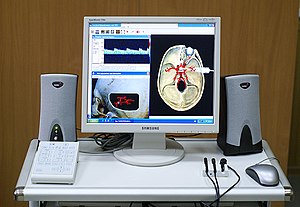Doppler Flow Meter
Doppler Flow meter or Doppler ultrasound flow meter is a device for measuring the volumetric flow of liquid through a tube ( blood through a vessels). It works on the principle ultrasound and doppler phenomenon, it can only be used for liquids containing particles (erythrocytes) or bubbles.
Basic parts[edit | edit source]
A Doppler flowmeter consists of a probe and a computer.
The volume required to detect flow can only be determined from measurements in a pulsed Doppler system. The probes of the flowmeters are therefore equipped with one piezoelectric crystal typical for this system. The probe is connected to a computer that processes the signals. The output values are read either from the device itself or from the connected screen. Probes with a frequency of 4 or 5 MHz are used to detect deeper-seated vessels, and usually 8 or 10 MHz to examine superficial vessels. [pozn. 1]
The principle of operation of the device[edit | edit source]
An electrical impulse is sent from the device's computer to the probe's crystal. The electric voltage based on the inverse piezoelectric effect deforms the crystal, which creates ultrasound. It passes from the probe into the body, reflects off the moving erythrocytes with a different frequency than the initial one (according to the doppler effect) and heads back to the probe. The crystal is mechanically deformed by this ultrasonic wave and generates an electric voltage (piezoelectric phenomenon). The electrical impulse created in this way is compared in the computer with the original impulse.
Output values[edit | edit source]
- The speed of moving particles (change in frequency) – is given by the average speed, which is determined from the speeds in the whole vessel (the speed is not the same everywhere. It is the slowest at the walls, the fastest in the center of the lumina). So calculated from the integral of the Doppler spectrum. To accurately determine the mean velocity, it is necessary to have the cursor correctly set so that it covers the entire diameter of the vessel.
- The depth of the vessel – determined based on the time interval between the sending of the signal and the beginning of its reception.
- The diameter of the vessels (from which we can determine the volume) - determined from the time interval between the beginning and end of receiving the signal..[pozn. 2]
The flow rate is calculated from the speed of blood that has flowed through the volume of a given vessel profile in a certain time.
Uses in medicine[edit | edit source]
- Examination of the lower limbs of diabetic patients.
- Determination of vessel lumen and blood flow velocity for the diagnosis of related problems (Aneurysm, strokes, thrombosis, porušené impaired organ functions,...).
Footnotes[edit | edit source]
- ↑ Higher frequencies of ultrasound are absorbed to a greater extent than lower frequencies, therefore more penetrating lower frequencies are used for deeper structures, which, on the other hand, do not have as good a resolution as higher frequencies.
- ↑ The depth (or diameter) of the vessel is not determined only by the value of the time interval, because the ultrasound goes at a certain angle(doppler angle –so that the doppler phenomenon can be achieved). The angle is known and displayed on the device screen. Furthermore, thanks to the already mentioned time interval between sending the signal and the beginning (or end) of its reception, the distance between the probe and the point of reflection is determined. If a perpendicular from the probe (or from the place of initial wave reflection) is led to the given structure and at the same time the point of intersection of this perpendicular is connected with the place of initial (or final) wave reflection, a right-angled triangle is formed with all angles known and the length of one side known , from which the length of the perpendicular is calculated, which determines the depth of the vessel (or diameter of the vessel).
Links[edit | edit source]
Related Articles[edit | edit source]
External links[edit | edit source]
References[edit | edit source]
- ELIÁŠ, Pavel – ŽIŽKA, Jan. Dopplerovská ultrasonografie. 1. edition. Hradec Králové : Nucleus, 1998. ISBN 80-901753-5-X.
- wikipedia. Piezoelektrický jev [online]. [cit. 2013-11-19]. <https://cs.wikipedia.org/wiki/Piezoelektrick%C3%BD_jev>.
- wikipedia. Piezoelectricity [online]. [cit. 2013-11-19]. <https://en.wikipedia.org/wiki/Piezoelectricity>.
- wikipedia. Ultrazvukové vlnění [online]. [cit. 2013-12-11]. <https://www.wikiskripta.eu/w/Ultrazvukov%C3%A9_vln%C4%9Bn%C3%AD>.

